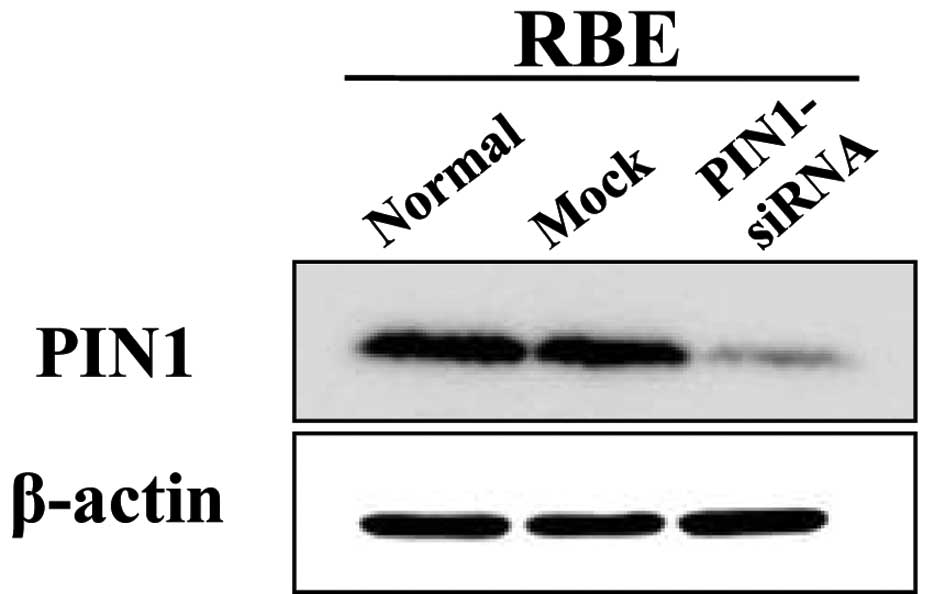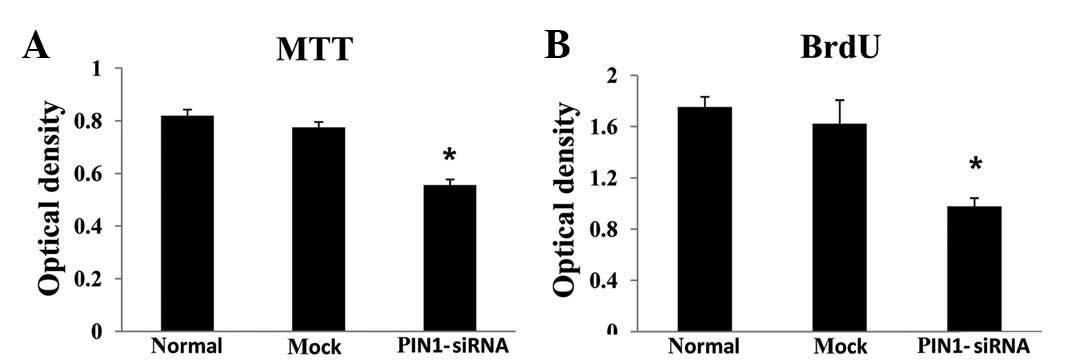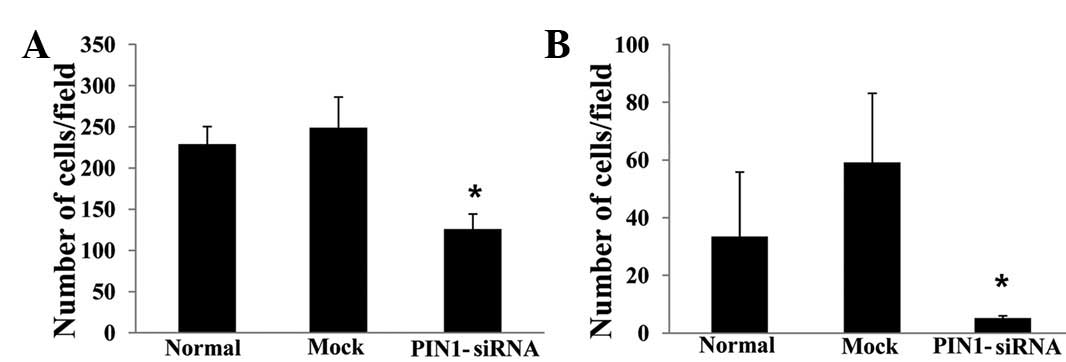|
1
|
Lazaridis KN and Gores GJ:
Cholangiocarcinoma. Gastroenterology. 128:1655–67. 2005. View Article : Google Scholar : PubMed/NCBI
|
|
2
|
Blume-Jensen P and Hunter T: Oncogenic
kinase signaling. Nature. 411:355–365. 2001. View Article : Google Scholar : PubMed/NCBI
|
|
3
|
Lippens G, Landrieu I and Smet C:
Molecular mechanisms of the phospho-dependent prolyl cis/trans
isomerase Pin1. FEBS J. 274:5211–5222. 2007. View Article : Google Scholar : PubMed/NCBI
|
|
4
|
Yeh ES and Means AR: PIN1, the cell cycle
and cancer. Nat Rev Cancer. 7:381–388. 2007. View Article : Google Scholar : PubMed/NCBI
|
|
5
|
Edge SB, Byrd DR, Compton CC, Fritz AG,
Greene FL and Trotti A: AJCC Cancer Staging Manual. 7th edition.
Springer; New York, NY: 2010
|
|
6
|
Kwon CY, Kim KR, Choi HN, et al: The role
of serum response factor in hepatocellular carcinoma: implications
for disease progression. Int J Oncol. 37:837–844. 2010.PubMed/NCBI
|
|
7
|
Finn G and Lu KP: Phosphorylation-specific
prolyl isomerase Pin1 as a new diagnostic and therapeutic target
for cancer. Curr Cancer Drug Targets. 8:223–229. 2008. View Article : Google Scholar : PubMed/NCBI
|
|
8
|
Ryo A, Liou YC, Lu KP and Wulf G: Prolyl
isomerase Pin1: a catalyst for oncogenesis and a potential
therapeutic target in cancer. J Cell Sci. 116:773–783. 2003.
View Article : Google Scholar : PubMed/NCBI
|
|
9
|
Ryo A, Nakamura M, Wulf G, Liou YC and Lu
KP: Pin1 regulates turnover and subcellular localization of
beta-catenin by inhibiting its interaction with APC. Nat Cell Biol.
3:793–801. 2001. View Article : Google Scholar : PubMed/NCBI
|
|
10
|
Wulf GM, Ryo A, Wulf GG, et al: Pin1 is
overexpressed in breast cancer and cooperates with Ras signaling in
increasing the transcriptional activity of c-Jun towards cyclin D1.
EMBO J. 20:3459–3472. 2001. View Article : Google Scholar : PubMed/NCBI
|
|
11
|
Bao L, Kimzey A, Sauter G, Sowadski JM, Lu
KP and Wang DG: Prevalent overexpression of prolyl isomerase Pin1
in human cancers. Am J Pathol. 164:1727–1737. 2004. View Article : Google Scholar : PubMed/NCBI
|
|
12
|
Ryo A, Uemura H, Ishiguro H, et al: Stable
suppression of tumorigenicity by Pin1-targeted RNA interference in
prostate cancer. Clin Cancer Res. 11:7523–7531. 2005. View Article : Google Scholar : PubMed/NCBI
|
|
13
|
Pang RW, Lee TK, Man K, et al: PIN1
expression contributes to hepatic carcinogenesis. J Pathol.
210:19–25. 2006. View Article : Google Scholar : PubMed/NCBI
|
|
14
|
Atchison FW, Capel B and Means AR: Pin1
regulates the timing of mammalian primordial germ cell
proliferation. Development. 130:3579–3586. 2003. View Article : Google Scholar : PubMed/NCBI
|
|
15
|
Joseph JD, Daigle SN and Means AR: PINA is
essential for growth and positively influences NIMA function in
Aspergillus nidulans. J Biol Chem. 279:32373–32384. 2004.
View Article : Google Scholar : PubMed/NCBI
|
|
16
|
Yeh ES, Lew BO and Means AR: The loss of
PIN1 deregulates cyclin E and sensitizes mouse embryo fibroblasts
to genomic instability. J Biol Chem. 281:241–251. 2006. View Article : Google Scholar : PubMed/NCBI
|
|
17
|
Yeh E, Cunningham M, Arnold H, et al: A
signalling pathway controlling c-Myc degradation that impacts
oncogenic transformation of human cells. Nat Cell Biol. 6:308–318.
2004. View
Article : Google Scholar : PubMed/NCBI
|
|
18
|
Tan X, Zhou F, Wan J, et al: Pin1
expression contributes to lung cancer: Prognosis and
carcinogenesis. Cancer Biol Ther. 9:111–119. 2010. View Article : Google Scholar : PubMed/NCBI
|
|
19
|
Ayala G, Wang D, Wulf G, et al: The prolyl
isomerase Pin1 is a novel prognostic marker in human prostate
cancer. Cancer Res. 63:6244–6251. 2003.PubMed/NCBI
|
|
20
|
Teng BL, Hacker KE, Chen S, Means AR and
Rathmell WK: Tumor suppressive activity of prolyl isomerase Pin1 in
renal cell carcinoma. Mol Oncol. 5:465–474. 2011. View Article : Google Scholar : PubMed/NCBI
|
|
21
|
Lill C, Schneider S, Pammer J, et al:
Significant correlation of peptidyl-prolyl isomerase overexpression
in Merkel cell carcinoma with overall survival of patients. Head
Neck. 33:1294–1300. 2011. View Article : Google Scholar : PubMed/NCBI
|
|
22
|
Zacchi P, Gostissa M, Uchida T, et al: The
prolyl isomerase Pin1 reveals a mechanism to control p53 functions
after genotoxic insults. Nature. 419:853–857. 2002. View Article : Google Scholar : PubMed/NCBI
|
|
23
|
Wulf GM, Liou YC, Ryo A, Lee SW and Lu KP:
Role of Pin1 in the regulation of p53 stability and p21
transactivation, and cell cycle checkpoints in response to DNA
damage. J Biol Chem. 277:47976–47979. 2002. View Article : Google Scholar : PubMed/NCBI
|
|
24
|
Girardini JE, Napoli M, Piazza S, et al: A
Pin1/mutant p53 axis promotes aggressiveness in breast cancer.
Cancer Cell. 20:79–91. 2011. View Article : Google Scholar : PubMed/NCBI
|
|
25
|
Harris CC: Structure and function of the
p53 tumor suppressor gene: clues for rational cancer therapeutic
strategies. J Natl Cancer Inst. 88:1442–1455. 1996. View Article : Google Scholar : PubMed/NCBI
|
|
26
|
Khan SA, Thomas HC, Toledano MB, Cox IJ
and Taylor-Robinson SD: p53 Mutations in human cholangiocarcinoma:
a review. Liver Int. 25:704–716. 2005. View Article : Google Scholar : PubMed/NCBI
|
|
27
|
He J, Zhou F, Shao K, et al:
Overexpression of Pin1 in non-small cell lung cancer (NSCLC) and
its correlation with lymph node metastases. Lung Cancer. 56:51–58.
2007. View Article : Google Scholar : PubMed/NCBI
|
|
28
|
Jin J, Zhang Y, Li Y, et al:
RNA-interference-mediated downregulation of Pin1 suppresses
tumorigenicity of malignant melanoma A375 cells. Neoplasma.
60:92–100. 2013. View Article : Google Scholar : PubMed/NCBI
|
|
29
|
Matsuura I, Chiang KN, Lai CY, et al: Pin1
promotes transforming growth factor-beta-induced migration and
invasion. J Biol Chem. 285:1754–1764. 2010. View Article : Google Scholar : PubMed/NCBI
|


















